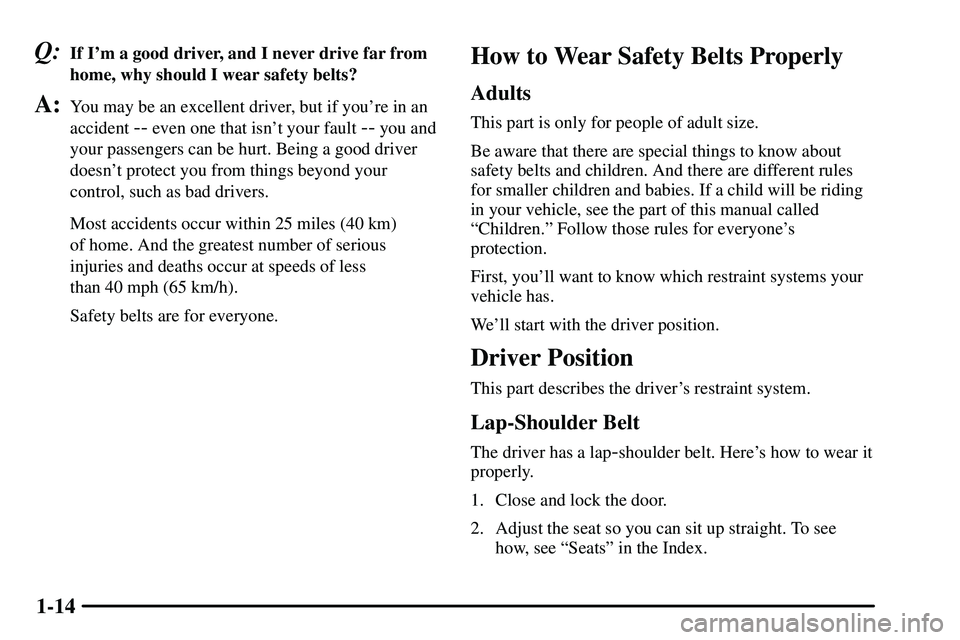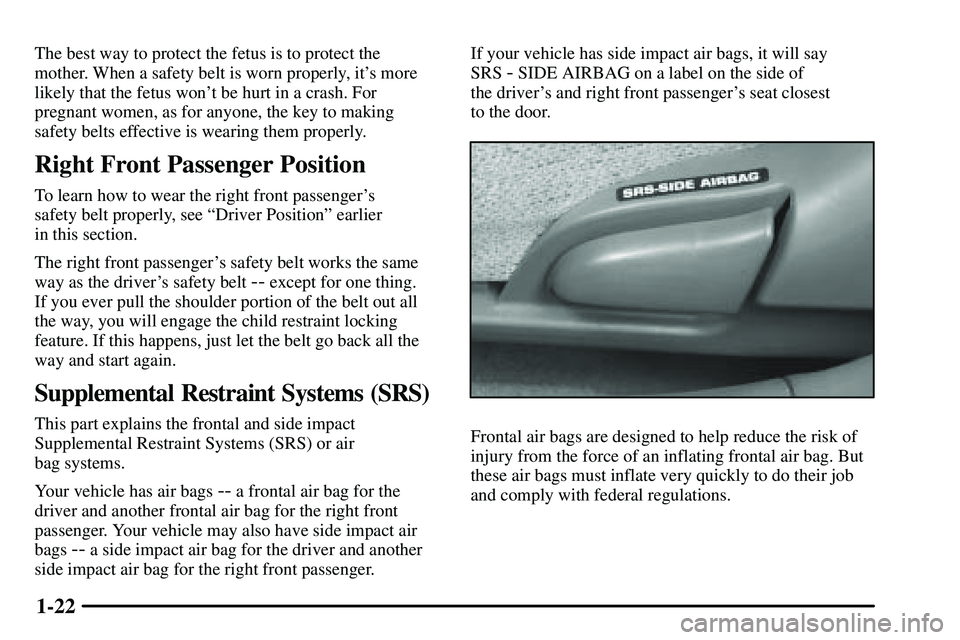Page 20 of 381

1-14
Q:If I'm a good driver, and I never drive far from
home, why should I wear safety belts?
A:You may be an excellent driver, but if you're in an
accident
-- even one that isn't your fault -- you and
your passengers can be hurt. Being a good driver
doesn't protect you from things beyond your
control, such as bad drivers.
Most accidents occur within 25 miles (40 km)
of home. And the greatest number of serious
injuries and deaths occur at speeds of less
than 40 mph (65 km/h).
Safety belts are for everyone.
How to Wear Safety Belts Properly
Adults
This part is only for people of adult size.
Be aware that there are special things to know about
safety belts and children. And there are different rules
for smaller children and babies. If a child will be riding
in your vehicle, see the part of this manual called
ªChildren.º Follow those rules for everyone's
protection.
First, you'll want to know which restraint systems your
vehicle has.
We'll start with the driver position.
Driver Position
This part describes the driver's restraint system.
Lap-Shoulder Belt
The driver has a lap-shoulder belt. Here's how to wear it
properly.
1. Close and lock the door.
2. Adjust the seat so you can sit up straight. To see
how, see ªSeatsº in the Index.
Page 28 of 381

1-22
The best way to protect the fetus is to protect the
mother. When a safety belt is worn properly, it's more
likely that the fetus won't be hurt in a crash. For
pregnant women, as for anyone, the key to making
safety belts effective is wearing them properly.
Right Front Passenger Position
To learn how to wear the right front passenger's
safety belt properly, see ªDriver Positionº earlier
in this section.
The right front passenger's safety belt works the same
way as the driver's safety belt
-- except for one thing.
If you ever pull the shoulder portion of the belt out all
the way, you will engage the child restraint locking
feature. If this happens, just let the belt go back all the
way and start again.
Supplemental Restraint Systems (SRS)
This part explains the frontal and side impact
Supplemental Restraint Systems (SRS) or air
bag systems.
Your vehicle has air bags
-- a frontal air bag for the
driver and another frontal air bag for the right front
passenger. Your vehicle may also have side impact air
bags
-- a side impact air bag for the driver and another
side impact air bag for the right front passenger.If your vehicle has side impact air bags, it will say
SRS
- SIDE AIRBAG on a label on the side of
the driver's and right front passenger's seat closest
to the door.
Frontal air bags are designed to help reduce the risk of
injury from the force of an inflating frontal air bag. But
these air bags must inflate very quickly to do their job
and comply with federal regulations.
Page 32 of 381
1-26
The right front passenger's side impact air bag is in the
side of the passenger's seatback closest to the door.
CAUTION:
If something is between an occupant and an air
bag, the bag might not inflate properly or it
might force the object into that person causing
severe injury or even death. The path of an
inflating air bag must be kept clear. Don't put
anything between an occupant and an air bag,
and don't attach or put anything on the steering
wheel hub or on or near any other air bag
covering. Don't let seat covers block the inflation
path of a side impact air bag.
Page 65 of 381

2-
2-1
Section 2 Features and Controls
Here you can learn about the many standard and optional features on your vehicle, and information on starting,
shifting and braking. Also explained are the instrument panel and the warning systems that tell you if everything is
working properly
-- and what to do if you have a problem.
2
-2 Windows
2
-4 Keys
2
-6 Door Locks
2
-9 Remote Keyless Entry System (If Equipped)
2
-12 Liftgate/Liftglass
2
-14 Theft
2
-17 New Vehicle ªBreak-Inº
2
-18 Ignition Positions
2
-19 Starting Your Engine
2
-21 Engine Coolant Heater (If Equipped)
2
-22 Automatic Transaxle Operation
2
-25 Manual Transaxle Operation
2
-29 Parking Brake
2
-30 Shifting Into PARK (P)
(Automatic Transaxle Only)
2
-32 Shifting Out of PARK (P)
(Automatic Transaxle Only)
2
-33 Parking Your Vehicle
(Manual Transaxle Only)
2
-33 Parking Over Things That Burn2
-34 Engine Exhaust
2
-34 Running Your Engine While You're Parked
(Automatic Transaxle)
2
-35 Horn
2
-35 Tilt Wheel
2
-36 Turn Signal/Multifunction Lever
2
-38 Windshield Washer
2
-39 Cruise Control (Option)
2
-42 Exterior Lamps
2
-44 Interior Lamps
2
-46 Mirrors
2
-48 Storage Compartments
2
-53 Ashtrays and Cigarette Lighter
2
-53 Sun Visors
2
-57 Sunroof (Option)
2
-58 The Instrument Panel -- Your
Information System
2
-60 Instrument Panel Cluster
2
-62 Warning Lights, Gages and Indicators
2
-76 Navigation System (Option)
Page 67 of 381
2-3 Manual Windows
Use the window crank to open and close each window.
Power Windows (Option)
If your vehicle has this
option, the switches
controlling the driver's and
passenger's windows are
located on the driver's door.
The power window switch on each passenger door
controls that window only. These switches work while
the ignition is on.
For the front windows, press the front of a switch to
lower a window and lift the front of the switch to raise a
window. For the rear windows, the power window lever
is located on each door below the arm rest.AUTO (Express
-Down): Press this switch all
the way down and release it to lower the driver's
window quickly.
Lock-Out: Press the
window lock
-out button,
located next to the driver's
power door lock switch, to
disable the passenger's
power window switches.
Press the button again to
enable the window
switches.
The driver can still control the left front passenger
window with the lock
-out button pressed.
Page 69 of 381
2-5
One key is used for the
ignition, the doors and all
other locks.
When a new vehicle is delivered, the dealer removes the
key tag from the key and gives it to the first owner.
Each tag has a code on it that tells your dealer or a
qualified locksmith how to make extra keys. Keep the
tag in a safe place. If you lose your key, you'll be able to
have a new one made easily using this code.
If you need a new key, contact your dealership to obtain
the correct key code. See ªRoadside Assistanceº in the
Index for more information.
NOTICE:
Your vehicle has a number of features that can
help prevent theft. However, you can have a lot of
trouble getting into your vehicle if you ever lock
your key inside. You may even have to damage
your vehicle to get in. So be sure you have an
extra key.
Page 70 of 381
2-6
Door Locks
CAUTION:
Unlocked doors can be dangerous.
�Passengers -- especially children -- can
easily open the doors and fall out of a
moving vehicle. When a door is locked, the
handle won't open it. You increase the
chance of being thrown out of the vehicle in
a crash if the doors aren't locked. So, wear
safety belts properly and lock the doors
whenever you drive.
�Young children who get into unlocked
vehicles may be unable to get out. A child
can be overcome by extreme heat and can
suffer permanent injuries or even death
from heat stroke. Always lock your vehicle
whenever you leave it.
�Outsiders can easily enter through an
unlocked door when you slow down or stop
your vehicle. Locking your doors can help
prevent this from happening.
There are several ways to lock and unlock your vehicle.
From the outside, use your key or the remote keyless
entry transmitter, if equipped. See ªRemote Keyless
Entryº in the Index for more information.
Page 71 of 381
2-7
To manually lock the door from the inside, press the
knob on the door forward. To unlock the door, press the
knob rearward. If you have manual locks, you must use
the key to lock and unlock the tailgate.
If your vehicle has power door locks, open the driver's
door by turning the key in the lock toward the rear of the
vehicle. Turning the key back toward the center, then
toward the rear again will unlock all of the doors. Using
the key in the passenger's door will also unlock all of
the doors.
Lock a door by turning the key toward the front of
the vehicle. If you have power door locks, all the
doors will lock.Power Door Locks (Option)
The power door lock switch
is located on the armrest on
the door.
Press the power door lock switch on the driver's or
passenger's door to lock or unlock all the doors at once.